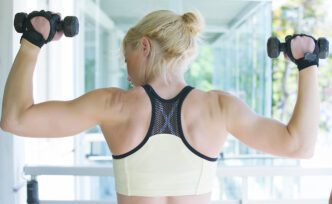A Quick Takeaway
The Story Behind the Trend
How to Make It Work for You
The Community View
Achieving strong, defined shoulders is a cornerstone for anyone looking to sculpt a powerful and balanced physique, enhancing both aesthetic appeal and functional strength. These top exercises target the intricate musculature of the deltoids, allowing individuals of all fitness levels to build impressive shoulder caps, improve posture, and bolster overall upper body stability. By consistently incorporating a thoughtful selection of movements that work all three heads of the deltoid, you can effectively develop robust, well-rounded shoulders that contribute significantly to a healthy, active lifestyle.
Understanding Shoulder Anatomy for Optimal Development
The shoulder joint is one of the most mobile in the human body, supported by a complex network of muscles, tendons, and ligaments. The primary muscle group responsible for the rounded appearance and strength of the shoulder is the deltoid, which is comprised of three distinct heads: the anterior (front), medial (side), and posterior (rear) deltoids. Each head plays a crucial role in different movements and requires specific exercises for comprehensive development.
The anterior deltoid is primarily involved in shoulder flexion and internal rotation, such as lifting your arm forward. The medial deltoid is responsible for shoulder abduction, or lifting your arm out to the side. Lastly, the posterior deltoid handles shoulder extension and external rotation, crucial for pulling movements and maintaining good posture.
Beyond Aesthetics: The Benefits of Strong Shoulders
While a sculpted set of shoulders undoubtedly contributes to an impressive physique, the benefits extend far beyond appearance. Strong deltoids and supporting shoulder muscles are vital for everyday functional movements, from lifting groceries to reaching overhead. They play a critical role in stabilizing the shoulder joint, which is inherently prone to injury due to its mobility. Developing robust shoulder strength can significantly reduce the risk of common issues like impingement, rotator cuff tears, and dislocations. Furthermore, well-developed posterior deltoids and upper back muscles contribute to improved posture, helping to counteract the rounded-shoulder posture often associated with desk work and prolonged sitting.
Top Exercises for a Strong, Defined Physique
To effectively sculpt your shoulders, your workout routine must include exercises that target all three heads of the deltoid. A combination of compound and isolation movements will ensure balanced development and strength.
Anterior Deltoid Dominant Exercises
The anterior deltoid gets significant work during most pressing movements. However, specific exercises can emphasize its development.
Overhead Press (Barbell or Dumbbell): Often considered the king of shoulder exercises, the overhead press is a compound movement that works the anterior and medial deltoids, triceps, and core. Whether performed standing or seated, with a barbell or dumbbells, it builds foundational strength and mass. Ensure a stable base and press the weight directly overhead, controlling the descent.
Dumbbell Front Raises: This isolation exercise targets the anterior deltoid by lifting dumbbells directly in front of you. Keep the movement controlled, avoiding momentum, and raise the weights to shoulder height. Focus on feeling the contraction in the front of your shoulders rather than relying on your traps or lower back.
Medial Deltoid Dominant Exercises
The medial deltoid is key to achieving that wide, capped shoulder look.
Dumbbell Lateral Raises: Perhaps the most effective isolation exercise for the medial deltoid, lateral raises involve lifting dumbbells out to the sides. Maintain a slight bend in your elbows and lift until your arms are parallel to the floor, focusing on leading with your elbows. Avoid shrugging, which shifts the emphasis to the traps.
Cable Lateral Raises: Using a cable machine provides constant tension throughout the entire range of motion, which can be highly effective for stimulating the medial deltoid. Stand sideways to the machine and perform the raise as you would with dumbbells, feeling the continuous resistance.
Upright Rows (with caution): While effective for the medial deltoids and traps, upright rows can place stress on the shoulder joint for some individuals. If performing, use a wider grip to minimize internal rotation of the shoulder and keep the pull controlled, stopping when your elbows are just above your shoulders.
Posterior Deltoid Dominant Exercises
Often neglected, the posterior deltoid is crucial for shoulder health, posture, and a balanced physique.
Bent-Over Reverse Flyes (Dumbbell or Machine): This exercise specifically targets the posterior deltoid. Hinge at your hips, keeping your back straight, and let your arms hang with a slight bend in the elbows. Raise the dumbbells out to the sides, squeezing your shoulder blades together, as if trying to touch them. Focus on the rear of your shoulders, not your traps.
Face Pulls: Performed with a rope attachment on a cable machine, face pulls are excellent for the posterior deltoids and rotator cuff muscles. Pull the rope towards your face, externally rotating your shoulders as you do so, aiming to bring your hands to either side of your ears. This movement is fantastic for shoulder health and posture.
Programming for Success
To see consistent results, incorporate shoulder exercises into your routine 2-3 times per week, allowing for adequate recovery. For strength and hypertrophy, aim for 3-4 sets of 8-12 repetitions for most exercises. Always prioritize proper form over heavy weight to prevent injury and maximize muscle activation. Gradually increase the weight or repetitions over time, a principle known as progressive overload, to continue challenging your muscles and stimulate growth. Remember to include a thorough warm-up before your workout and a cool-down with stretches afterward to improve flexibility and aid recovery.
Building Your Strongest Shoulders
Developing strong, defined shoulders requires a strategic approach that targets all three heads of the deltoid with consistency and proper form. By integrating compound movements like the overhead press with isolation exercises such as lateral raises and reverse flyes, you can build a balanced, powerful, and aesthetically pleasing set of shoulders. Prioritize progressive overload, listen to your body, and commit to a well-rounded routine to unlock your full potential and support a lifetime of functional strength and improved posture.








